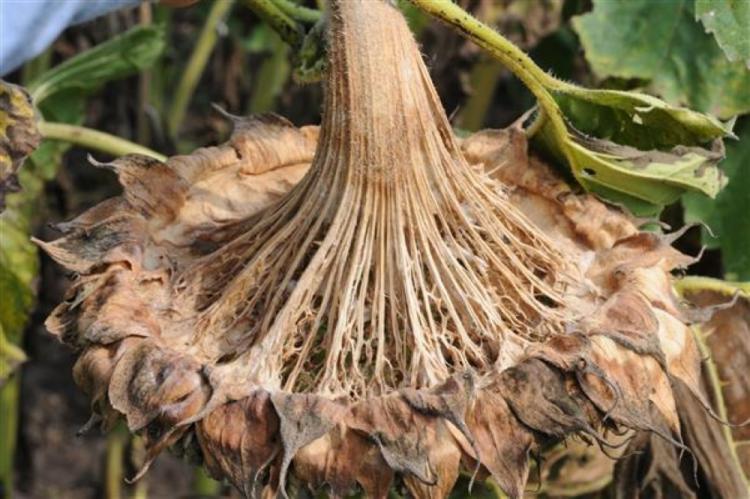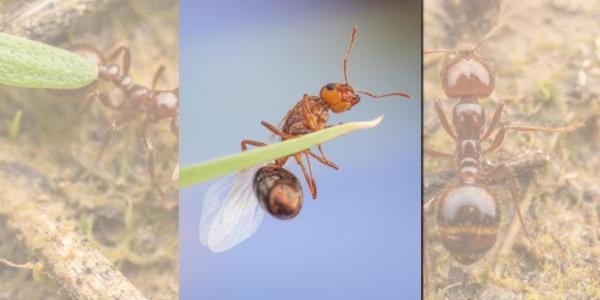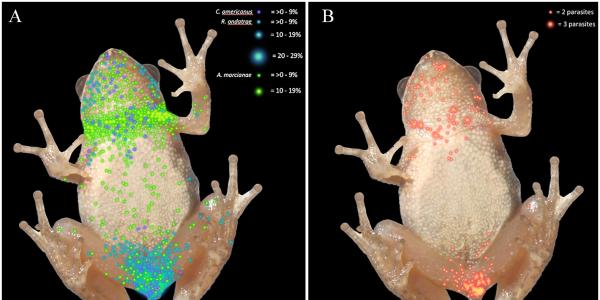A CU Boulder-led study of sunflowers shows that their genes relate to the abundance of bacteria associated with resistance against one of the pathogens that causes white mold
Sunflowers aren’t just beautiful symbols of summer—they are also economically significant, ranking as the fourth most important oilseed crop in the world, and new research suggests that some bacteria might help protect the crop from white-mold destruction.
Sunflowers can be harvested for a number of products including seeds and oil, for which consumer demand has increased significantly in recent years. They may also contribute to climate resilience, researchers note, since they can adapt to various weather conditions, and sunflower sprouts contain nutrients that can promote human health.
Unfortunately, like many other plants, sunflowers are susceptible to disease, which can cause significant crop losses. For example, white mold, which is caused by the fungal pathogen Sclerotinia sclerotiorum, is responsible for average annual sunflower crop losses of more than 1%. It can also affect beans, eggplants, lettuce, peanuts, potatoes and soybeans, in some cases destroying 100% of crops.

Nolan Kane, a CU Boulder associate professor of ecology and evolutionary biology, and his research colleagues found that some bacteria in the soil around a sunflower's roots may help protect them from white mold infection.
While the approach to managing diseases such as white mold has typically focused on plant genetics, a study recently published in Molecular Ecology and led by University of Colorado Boulder researchers suggests that the communities of microscopic organisms around plants’ roots play a major role, too, and that plant genetic variation does, in fact, affect associated microbiomes.
Field and greenhouse experiments
The research included a greenhouse study as well as a field experiment that the researchers conducted using different breeds of sunflowers whose DNA they extracted and sequenced. Twenty plants of each sunflower breed were grown in a single field that researchers expected to contain microbes hostile to the Sclerotinia pathogen. Some of the plants were infected, while others were not, which was necessary to distinguish between microbes that were relevant to the study and those taking advantage of the tissue death caused by Sclerotinia.
In the greenhouse experiment, sunflowers were grown in soil taken from the same environment used in the field experiment, half of which had been sterilized to remove any microbes. The plants were infected and evaluated for their resistance to the disease, allowing researchers to determine the significance of the microbes to the results that different breeds of sunflower experienced in the field experiment. If the sunflowers grown in sterile soil were less resistant to disease, this would show that the microbes were conferring disease resistance to their plants.
The researchers learned that 42 types of microbes were associated with disease resistance. The greenhouse experiment showed that these microbes are very important for plant disease resistance, since the sunflowers in sterile soil died as many as 19 days sooner than their counterparts. Next, the abundances of the main microbes were associated with the genetic characteristics of the different plants, and researchers found that certain genes corresponded to an increased abundance of the microbes.
This all suggests that different breeds of sunflower have adapted genetically to increase the number of helpful microbes in nearby soil and thereby improve their resistance to white mold, the researchers concluded. Since the association between plant and microbe is genetic, it can be inherited and it is therefore possible to cultivate this resistance through breeding, among other methods.
Microbes and plant disease resistance
Before the study, it was unclear how much effect microbial communities have on plant disease resistance, says Nolan Kane, a CU Boulder associate professor of ecology and evolutionary biology and noted sunflower researcher.
“There certainly are some documented cases of this being important,” he says, “but for most pathogens, plants have the right allele at this one gene, and they’ll be resistant to that pathogen, and if they don’t have the right allele, then they’ll be susceptible.
“(Humans) have a very complex immune system that can recognize new proteins all the time. Plants have a very different immune system that often gets simplified down to just one gene that detects the pathogen. If the pathogen protein is a version that the gene can detect, then the plant will be resistant, but if there’s not the right match, the plant will be susceptible.”
Unlike human immune systems, plant immune systems do not keep records of every microbe they’ve fought off. Instead, they recognize molecular patterns associated with disease using specialized receptors. Each type of receptor can only interact with molecules of particular shapes, which fit together like matching puzzle pieces. Once this contact is made, the receptor signals a defense response.

White mold, which is caused by the fungal pathogen Sclerotinia sclerotiorum, is responsible for average annual sunflower crop losses of more than 1%. (Photo: National Sunflower Association)
In the case of the sunflowers that Kane and his research colleagues studied, at least for Sclerotinia, things are more complicated. “This was a case where we really thought there might be an important role for the microbiome or some other environmental component,” Kane says. As the researchers discovered, four types of bacteria were strongly correlated with sunflowers’ resistance to the fungal pathogen, suggesting their intuition was correct.
However, Kane says, “there were a lot of microbes that were correlated with each other,” meaning the effect could be a result of the whole community rather than just these four types of bacteria, which are called operational taxonomic units (OTUs).
Still, Kane continues, “the four that we highlighted are most strongly correlated with pathogen resistance, and when we control for those four, none of the other correlated OTUs were significant in association with the disease,” though the main four bacteria probably could not improve disease resistance individually, since “a lot of these microbes don’t grow very well by themselves, or don’t behave the same way when they’re cultured on their own.”
Plant/microbe symbiosis
The researchers found that the more of these four bacteria there were in the soil around the plants, the better they fared against Sclerotinia sclerotiorum. So, how are plants able to take advantage of these bacteria, and what does this have to do with plant genetics?
As it turns out, plants can cultivate a community of useful microbes in the area of soil around their roots, which is known as the rhizosphere.
“In general, there are compounds that plants can secrete that either inhibit certain microbes or promote their growth,” Kane explains. Photosynthesis, the process that plants use to convert light into usable energy, produces a lot of carbohydrate molecules like sugars and starches. For this reason, Kane says, “a lot of their interactions with microbes involve sugars or carbohydrates given by the plants, and the plants benefit by getting nitrogen or some other thing that they need back.”
Plants have similar sorts of symbiotic relationships with fungi that they benefit from promoting. Nitrogen is just one example of the benefits that plants get from their symbiotic relations: “In the study we did, we don’t know that it’s necessarily the same mechanism, but it’s likely that there’re some sort of root exudates that are shaping the microbiome,” Kane says. “That’s one of the key mechanisms plants use.”
The way that plants interact with microbes in the rhizosphere depends on their genes. For this reason, the researchers were able to associate the four types of bacteria with very specific parts of the sunflowers’ genetic codes.
Associations with microbes
The study had other significant findings as well. It showed that four of the 40 sunflower samples studied resisted Sclerotinia even without the protection of helpful bacteria. They did perform worse in sterilized soil than soil with bacteria but were significantly better off than the other samples.

CU Boulder researchers have found that sunflowers can cultivate a community of useful microbes in the area of soil around their roots.
“That could be some sort of ability to respond to the pathogen in ways that were protective,” Kane says. “We don’t yet know if that would be a useful breeding target because there could be tradeoffs, or it could have limited or no protective effects under normal conditions.” Still, “it does show that the whole story isn’t just the microbes. There is an important component, even if it’s smaller, related to the inherent plant genetics.”
The research inspired further questions about the costs and benefits of the symbiosis with the microbes, the molecular mechanisms responsible for the variation of the symbiosis and the significance of interactions between genotype and environmental factors. Kane says he and his research colleagues “are looking at some of these lines in more diverse environments across the U.S. and trying to identify whether these microbial associations are very general across a wide range of environments, or if they’re very specific to just one environment.”
Since these studies are being conducted in farmers’ fields, the plants being examined will not be exposed to pathogens. Instead, the researchers will focus on the plants’ associations with the microbes, Kane says.
Similarly, Kane says that “seeing these genetic effects in this one environment on so many different microbes was really exciting because it suggests that the sunflowers that we used in this study have some interesting variation that could be associated with a wide range of different traits that we didn’t look at, but that it would be really exciting to look at in future work.”
A lot of crops have lost some of their microbial associations through breeding, Kane says, but that wasn’t an issue with the study’s population, making it potentially valuable for future research.
The recently published study still provides an idea of how microbial associations could be used to protect plants on their own, though. The most straightforward way to do this is by selectively breeding plants for the genes corresponding to increased abundance of helpful microbes in the rhizosphere.
“In addition to the breeding,” Kane explains, “different farming practices and environmental practices could promote helpful communities or inhibit harmful communities.” In cases where the useful microbes aren’t already present, applying them to fields could be important, too. “It would probably be a combination of more than one of those different things,” Kane says. There are some biotechnology companies that are already working on beneficial microbial “concoctions” for some crops, which could be applied to fields or coated on plant seeds.
This study “could help, certainly with sunflower breeding,” Kane concludes, but also “help us to understand how to more effectively breed other species, and also some basic science of not just how plants interact with their environment, but how the whole community under the soil works to affect that interaction.”
Kane’s co-researchers include Cloe Pogoda, Kyle Keepers, Stephen Reinert, Ziv Attia, Jason Corwin, Erin Collier-zans and Alisha Quandt of the CU Boulder Department of Ecology and Evolutionary Biology; as well as Zahirul Talukder, Brian Smart, Kennedy Money, William Underwood and Thomas Gulya and Brent Hulke.
Did you enjoy this article? Subcribe to our newsletter. Passionate about ecology and evolutionary biology? Show your support.



